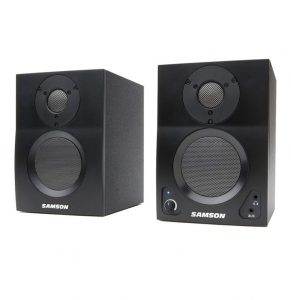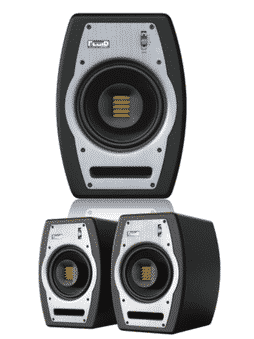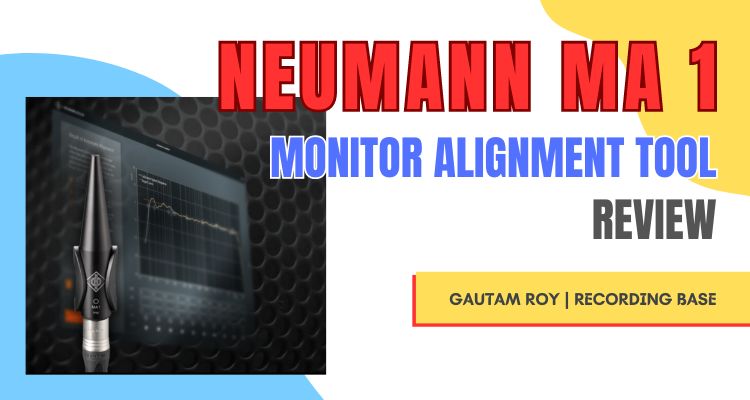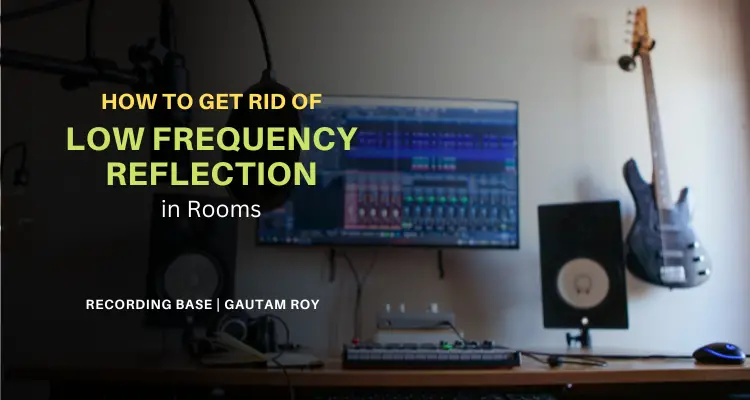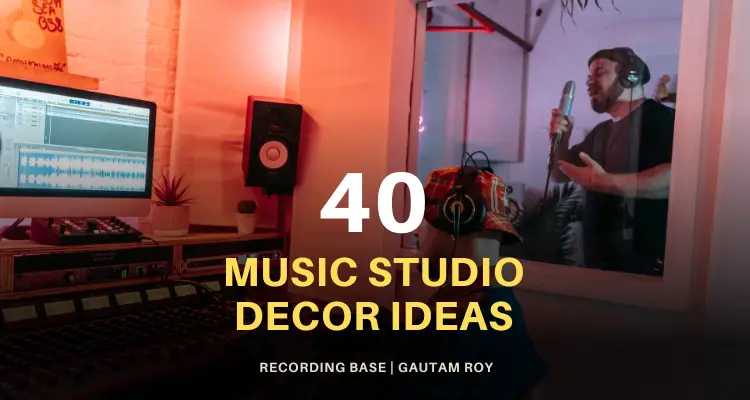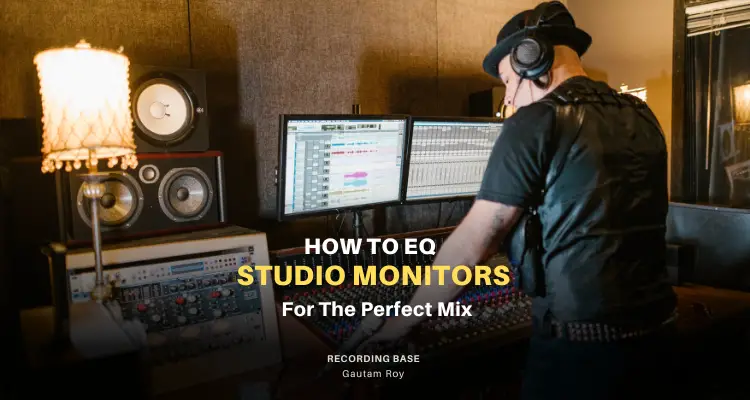Do you know, how to choose studio monitors for home studio?
If you are a newbie in the recording field, might be you don’t know the exact process of choosing recording hardware like studio monitors, audio interfaces, mixers and other studio equipment.
There are some factors, you should consider on before choosing a studio monitor for your home studio. Here are these factors.
- The wattage of Studio Monitors
- Active Vs Passive Monitors
- HeadRoom of a Monitor
- Frequency Response plays a big role in choosing a monitor for your studio
- Your Budget
- Home Studio Monitors Vs Professional Monitors
- Design and Durability
- Input/Output
In this article, I will show you how you can choose the best studio monitor according to above factors.
Here is the brief what you will read in this.
Table of Contents
- 1 How to Choose studio monitors
- 2 The wattage of Studio Monitors
- 3 Active Vs Passive Monitors
- 4 Monitor Headroom
- 5 Frequency Response plays a big role in choosing a monitor for your studio
- 6 Your Budget
- 7 Home Studio Monitors Vs Professional Monitors
- 8 Design and Durability
- 9 Input/Output
- 10 The Final Decision
How to Choose studio monitors
In this article, I will go through all the factors mentioned above.
After reading this guide on how to choose studio monitor for the home studio you will be able to choose the best piece of the monitor for your studio.
In 2007 when I was started my career as a recording engineer I was also worried about choosing the best studio monitor pair for my studio.
Disclosure: This post may contain affiliate links, which means we may receive a commission if you click a link and purchase something that we recommended. Read more about Affiliate disclosure here.
Frankly saying, I was failed to choose the best one and as a result, I faced several difficulties in my mixing. Sound mixing is a very serious process. From sound recording to mixing there is a systematic process which you have to follow.
It involves musicians, recordist, mixing engineer as well as the hardware. If you wanna create good music and audio project, these all ingredients should be perfect.
The quality of studio monitors plays a big role in your recording process.
A bad studio monitor could ruin your whole projects.
If you can’t get a good quality sound then how could you imagine to give the best quality music to your clients?
NOW, let me explain how to choose studio monitors?
First off…
The wattage of Studio Monitors
The wattage of a speaker plays a big role in the quality of sound. But there are some factors you have to aware of before choosing the right wattage for your monitors.
Acoustic treatment – Soundproofing
Acoustic treatment is a process to scatter and damp direct sounds bumping into the walls of the studio. When monitor or mix a project we don’t like to listen to the reflections of sound mixed with the original sound.
So we do acoustic treatment to our studio rooms. But acoustic treatment has a negative effect too. A perfectly treated room absorbs most of the reflections hence we could suffer a lack of sound intensity, especially with low wattage monitors.
On the other hand, if your room is not acoustically treated, and if you use high wattage monitor speakers, We can’t handle that much sound.
You will get heavy reflections using high wattage monitors in a poorly treated room. The result would be a poor mixing quality.
So, you must know the wattage requirement according to room size and acoustic treatment quality.
An ideal monitor according to Room size
Watch this video to understand the proper monitor size according to room size and acoustic treatment.
This video will guide you to choose the best suitable monitor speaker for your studio.
Though the room size only does not affect the sound but acoustic level too. So the best method is to check practically which monitor suits your studio.
This method requires the monitors available on your hand. You have to buy them according to the room size table shown in the above video.
I know buying studio monitors for testing purpose is an expansive idea. Alternatively, you could borrow these monitors for the testing purpose from any of your friends or in your circle who is recordist if he owns the monitors.
The best hack is to first watch the above video as well as read some other references and choose ideal monitors according to your room size.
When you have a list of monitors according to your room size, you can either buy one of them or borrow for testing purposes.
If your room is neither poorly acoustic treated nor heavily treated, there is 90% chance that the monitors which you chose according to room size suit your studio.
How much Distortion Your Monitor Has?
The second and very important step to choose your studio monitors is checking the distortion level of your monitors.
Distortion is inversely proportional to the wattage of the monitor speaker and directly proportional to the volume level.
But before we go into this topic, we should know exactly what is the distortion?
You all know that any amplifier has a component called IC (Integrated circuit). Though in vintage amps there were transistors used in place of ICs.
But with time technology grew and IC’s came into demand. ICs are capable to produce more accurate sound than transistors.
In this digital era of the recording field, IC is very important cause it produces digital signals with a low distortion rate. Now come to the definition of distortion.
Distortion is a deformation in the original sound frequencies which takes place when the load of the output current is greater than the load of the input current in the IC. Due to this phenomena when we observe the sound, we can listen to some crackling sound.
Don’t worry I know you haven’t understood these technical terms. I will simplify things below, just keep reading. Let’s discuss the term distortion in common language.
Distortion depends on 2 things.
- The wattage of Amp Vs Wattage of Speaker
- Volume level
The wattage of Amp Vs Wattage of Speaker

As I told above distortion is inversely proportional to the wattage of the monitor. So a high wattage amp with a combination of low wattage speakers produces low distortion. Let’s take an example.
Assume we have a 100W amplifier and 70W speaker. Now when this system produces a sound and then there will be no distortion because the input current (amps wattage) is higher than output current (speaker wattage).
Simply when sound produces via this system, the amp can easily tackle the power requirement of speakers and no distortion occurs.
Just opposite to this condition, if we have a 70W amplifier and 100W speaker then the sound produced by this system has distorted sound frequencies.
The cause is the input current (amps wattage) is lower than output current (speaker wattage).
Volume level
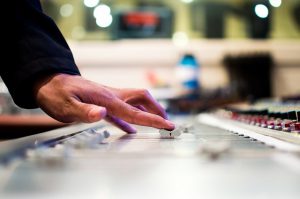
The second thing which impacts the amount of distortion is the Volume level. The volume level is a knob that controls the intensity of the current from the amp to speaker.
If the amp is underpowered according to the speaker and when we increase the volume level, distortion occurs after a certain level. Volume level distortion only applied to the underpowered amplifiers.
An ideal studio monitor has an amp built-in which has a slightly high wattage than the wattage of the speaker joined.
These type of monitors has the lowest amount of distortion at the high sound.
Note: In any monitor system (Active/Passive) don’t ever increase the volume up to the highest level as it will burn out your speakers.
So, when you are choosing monitors for home studio, you should be aware of the distortion level of the monitor. Most probably the distortion level would have been mentioned in the setup guide of your monitor speakers.
Active Vs Passive Monitors
Do you know what is the difference between active and passive monitor?
In simple words, a monitor that has a built-in amp into the box is called an active monitor. On the other hand, when the monitor has no built-in amp and requires a separate amplifier to produce sound, is called a passive monitor.
Passive Monitors
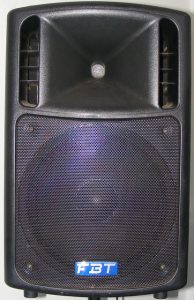
Generally, a passive monitoring system is used in PA systems like stage performances, etc. But big studios also use good passive monitor systems for monitoring purposes.
Do you know why I referenced “Big Studios” using passive monitors?
Passive monitors have two physical parts. Speakers and amps. Passive monitor amps usually come above 100W per channel which produces a big sound which only big studios by perfectly acoustic treated big studios.
- If you want to use a passive monitor system in your home studio then I will warn you that you will disturb your neighbors with that big amount of sound. I don’t recommend a passive monitor for home studios.
- The second demerit using passive monitor speakers in home studios is, they are far-field speakers and don’t give you the right amount of sound to your ears if placed near your ears. You can’t get a perfect mix with these far-field monitor speakers using them in your home studio. Though they are good for monitoring film scores etc on a big monitoring room. You can use them for that purpose. But don’t go for a mix if you have a small home studio.
- The third demerit of the passive monitor is it has an external monitor which occupy some extra space in your studio. Home studios are generally built in a small room and don’t have much space to place some extra equipment. So, using a passive monitor system is not a wise decision if you have a lack of space in your studio.
Active Monitors
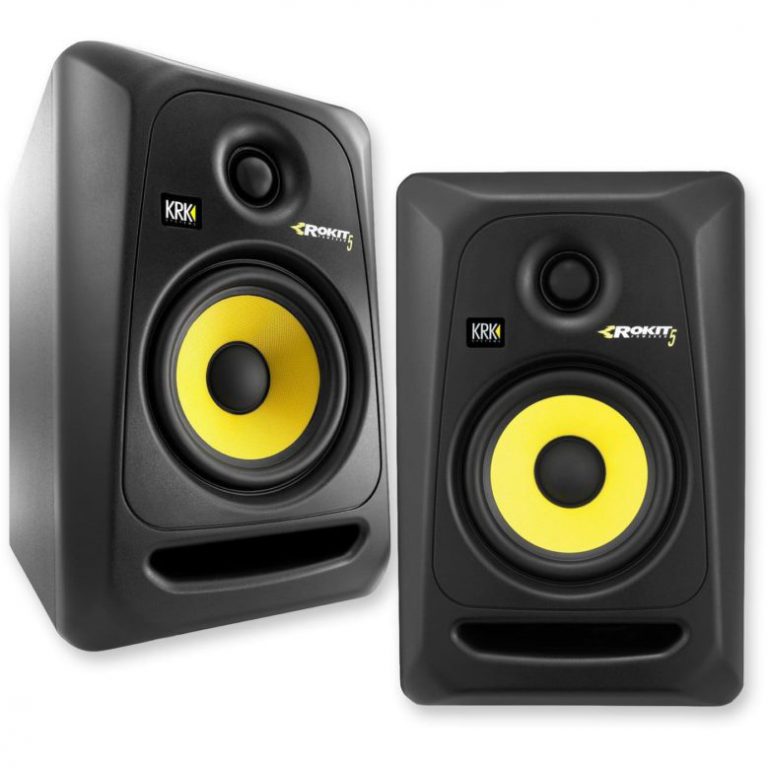
Active monitors have built-in amps and generally come in all sizes. you can buy on your requirement. They come from 3″ woofer size to 12″ woofer size and from 10W amp to 150W amps.
They are generally nearfield monitors so you can use them in any environment, either its the space just beside your bedroom’s bed or a fully professional and acoustically treated studio.
And of course, they are widely used for mixing purposes so you can also use them for that purpose.
If your main purpose is audio mixing then always go for active monitors.
I have a live recording studio where I have both 2 types of monitors. Generally, I use passive monitors for monitoring the live sound for musicians and my Yamaha active monitor pair, especially for the mixing purpose.
I never use my Yamaha HS8 monitor for monitoring in live recording as regular use of dedicated mixing monitors in high sound will damage the drivers of speakers with time which produces a negative effect on the mixing process.
Monitor Headroom
The headroom is a very important thing in sound recording. You must have to know about it and choose a monitor which has a sufficient amount of headroom.
I know you are wondering what is headroom?
So here is the definition.
Every studio monitor system is capable to handle signal up to a particular range which is called the nominal signal handling level of that monitor.
Manufacturers reserve a few extra dB above this nominal signal handling level which is called safety zone and allows transient audio peaks to exceed the nominal level without damaging the system or the audio signal.
This safety-zone is called the Headroom.
After exceeding this safety zone, the monitor started to produce distortion. In the worst condition, it could damage the speakers too.
You can refer to this image for a better understanding of headroom
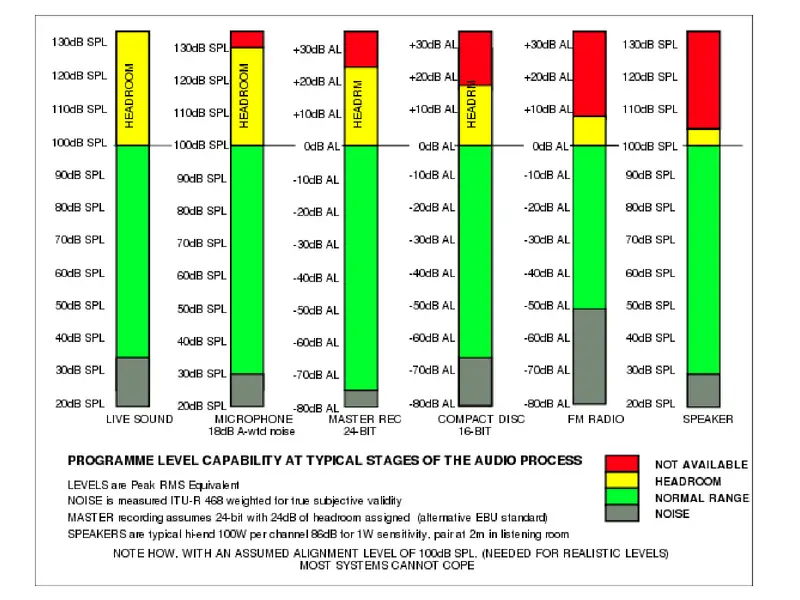
Obviously, more headroom means a more dynamic range and also more accurate mixing. Your monitor must have a good amount of headroom for a better mix. I know a question arrives on your mind that how much headroom is good for a better mix?
Generally, the above 4dB of the headroom is good for mixing. Don’t go for a monitor which has a headroom under 4dB. It will cause distortion and when you increase the sound level it could damage your monitors too.
If your monitor allows, use only balanced input cables as it will increase the headroom up to 4dB. Refer to your monitor’s manual to know if it supports balanced inputs.
Frequency Response plays a big role in choosing a monitor for your studio
Finally, we are going to discuss the very important factor regarding sound monitors.
Frequency Response
Before understanding the frequency response we should gain some basic knowledge of sound frequencies.
Though everything in the universe is able to produce sound frequencies. But here we are going to discuss only human observable sound frequencies.
As you already know, the human ear is capable to listen to frequencies between 20Hz to 20kHz.
A sound that we listen to is normally not a single frequency but a mixture of human observable sound frequencies between 20Hz to 20kHz.
Music is none other than perfectly mixed sound frequencies. In well-mixed music, we listen to these systematically arranged sound frequencies.
To mix a song perfectly, we must have our mixing equipment capable of delivering a nearly flat frequency curve or frequency response.
The main difference between a normal speaker and a good studio monitor is the shape of the frequency curve it delivers.
Monitors with a nearly flat frequency curve don’t add any extra frequency during the processing of the sound.
As flat as the frequency response of your studio monitor as an accurate mix you can achieve. For your convenience here is 2 graphical examples of frequency response.
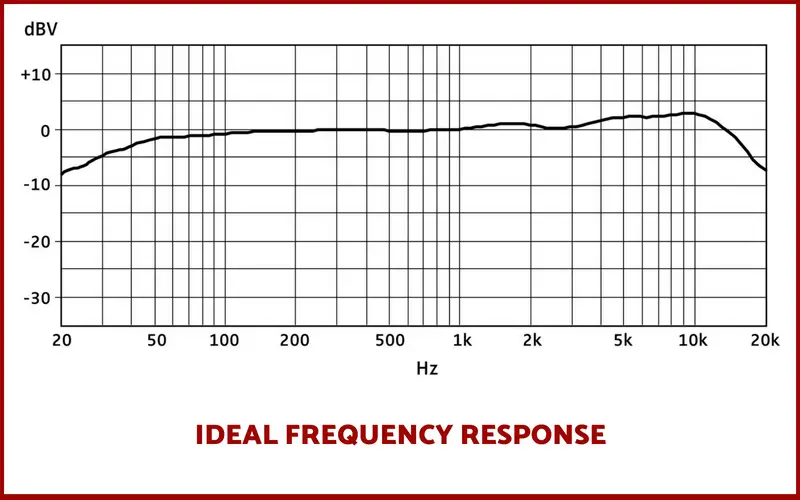
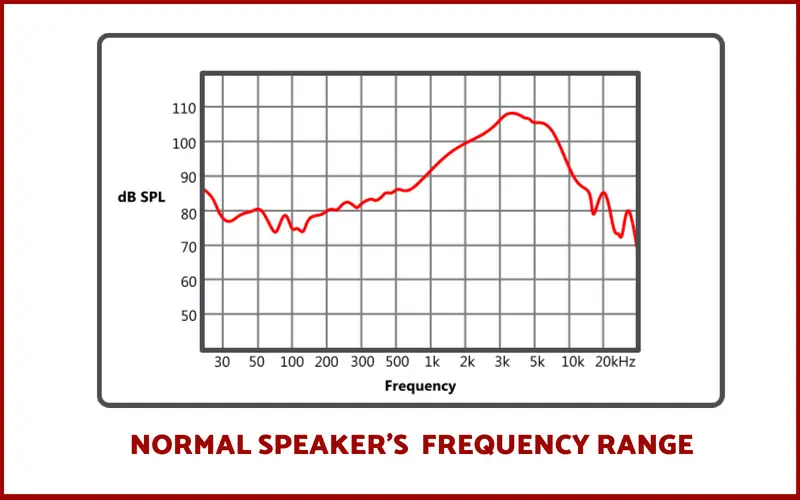
Understanding the frequency response graph
In the 2nd graph, you can clearly see a peak at 3kHz which means this speaker system delivers extra intensity at 3kHz with respect to the other sound frequencies.
Now suppose, if you mix a project in this speaker, you already listen to an added volume level at 3kHz and hence reduce the original level at that frequency level.
Now when you mixdown this project and listen on a music system you will experience low volume at 3kHz frequency range.
You mix will get sucked due to this unbalanced frequency response.
Now, go for the 1st graph. If you mix your project on a monitor speaker which delivers this frequency response, you can be able to output a perfect mix. Because there is no added frequency that could wander you from the original input frequency.
Your Budget
Do you know how much money you want to spend on a studio monitor?
If no, then find out…Because,
From the price point of view, we can divide monitors into 3 parts.
- Entry-level monitors
- Mid-range monitors
- High-range monitors
Entry-level Studio monitors
The price of this type of monitors ranges between $50-$200. As they are entry-level studio monitors, we can use them in only when we are starting up our recording studio. It does not mean that they are only for practicing purposes.
You can’t expect a pr mix by these monitors. Though you can monitor your audio at the time of recording by these monitors and they are also suitable small home studio mixes.
If you have a limited budget then you can checkout my article on Studio monitors under $100 where I have provided best studio monitor recommendations under your budget.
Mid-range Studio monitors
These monitors are widely used by home studios as well as pro studios. The price ranges from $200-$500.
Many big manufacturers found that this price range as a sweet spot for marketing, so many of them release their monitor models between this range.
Mid-range monitors are quite popular among recordists, mix engineers and producers. You can expect a pro mix with these monitors if you have already trained your ears for getting out better quality.
High Range Studio Monitors
These are pro studio monitors and especially used by Hollywood music studios. Their price ranges between $500-$7000. Generally, home studios can’t afford them as well as handle them. They require special acoustic treatment.
So, what is your price range?
There is a vast range of monitor speakers from $50-$7000. It all depends on your budget that which one you would choose.
If you want to know which are the best studio monitors under $1000 then checkout my article 10 Best Studio Monitors Under 1000 [2024 List]
Home Studio Monitors Vs Professional Monitors
As I already described the 3 types of monitors are according to price. But you can also divide them into 2 categories depending on the quality.
- Home studio monitors
- Professional Studio monitors
Home Studio Monitors
As from the name, home studio monitors are used widely in home studios. The main benefit of these monitors is they fit in your budget. There is a vast range of Home studio monitors from $50-$500.
You just scan my website and you will get the best home studio monitors under your budget.
Professional Studio Monitors
Professional studio monitors are very high-quality monitors and used in professional studios in Hollywood. You can’t afford them as they range between $500-$7000 which is a big investment as a home studio equipment.
If you have a home studio or going to start, I would suggest you go with high range home studio monitors like KRK Rokkit 5 or Yamaha HS series monitors.
With a little practice, these monitors will fulfill all the desires which you want in your mix.
Design and Durability
When you purchase equipment for your studio, your aspect that it will last longer as well as well designed so it could change the look of your studio.
So, design and durability is an important factor. You can’t aspect, with a small shock your monitor cabinet or internal parts to be damaged. You want a strong cabinet as well as durable internal parts.
Especially the components like ICs which radiate a huge amount of heat.
As well as you want your monitor to be stylish so it can enhance the look of your studio.
Choose a durable and stylish monitor. Go to the front page of Recording Base and you will find the best-picked monitors to choose from.
Input/Output
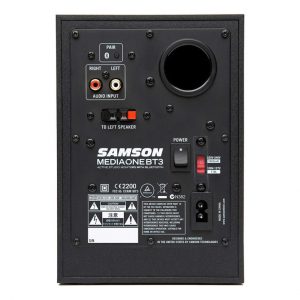
Input/output is a big factor in choosing a good monitor.
You should be aware that there is the same output port existed into the audio interface or mixer which input port you get in your monitor speaker.
If you overlook this factor you would be in trouble as you will have to buy input/output adaptor separately.
The other thing is to consider in the input/output section is Balanced and unbalanced cable support.
As you read in this article, balanced cable gives 4dB extra headroom for your mix so choosing a monitor with balanced cable support is a wise decision.
The Final Decision
I have tried here to light all the aspects which you should know before buying a studio monitor. Now it all depends on your decision. After all, you are going to invest in very important equipment for your studio.
I think this guide would have given some prior knowledge about studio monitors and help you to choose the best suits your needs.
If you have a query about this topic, the comment box is waiting for you. As well as share this article on your social circle that it could help other home and professional recordists.
You may also like,

